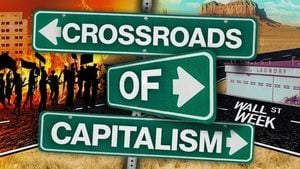October 2025 will be remembered as a pivotal month for the American workforce, with U.S. employers cutting more than 153,000 jobs—the highest figure for any October in over two decades. As reported by Challenger, Gray & Christmas, one of the nation’s largest outplacement firms, these layoffs mark a dramatic 183% increase from the previous month and signal a labor market under extraordinary strain. With official government employment data unavailable due to a protracted federal shutdown, private reports like this have become the primary lens through which economists and workers alike try to understand the shifting economic landscape.
“October’s pace of job cutting was much higher than average for the month,” Andy Challenger, chief revenue officer for Challenger, Gray & Christmas, told CBS News. “Some industries are correcting after the hiring boom of the pandemic, but this comes as AI adoption, softening consumer and corporate spending, and rising costs drive belt-tightening and hiring freezes.”
The numbers are staggering. According to Challenger, Gray & Christmas, the 153,074 jobs eliminated in October 2025 represent a 175% jump from the same month last year, making it the worst October for layoffs since 2003 and the worst single month in the fourth quarter since 2008. Year-to-date, U.S. employers have slashed 2,304,755 jobs, the highest total since the pandemic-ravaged year of 2020. Nearly 1.1 million of those cuts have come since January, and no year since 2020 has seen a higher tally through October.
Much of the reduction this year has been attributed to the so-called "DOGE impact"—the result of President Donald Trump’s Department of Government Efficiency. This effort led to almost 294,000 planned layoffs in 2025, including direct cuts to the government workforce and contractors. An additional 21,000 job losses have been traced to the downstream effects of DOGE, specifically reduced federal funding to private entities and nonprofits. As noted by Challenger, Gray & Christmas, these federal actions have sent ripples through the broader economy, affecting a wide swath of industries and communities.
But government policy is only part of the picture. Artificial intelligence is also reshaping the labor market at a breakneck pace. Technology companies led the way in October’s layoffs, followed closely by retail and service firms. Recent high-profile job cuts at Amazon, UPS, and Microsoft underscore this trend, as more employers turn to AI to streamline operations and reduce headcount. “Businesses that previously held off on reductions now lean on AI to replace human workers,” Challenger explained to CBS News. The result? Employees laid off in this climate are finding it harder than ever to quickly secure new roles, a dynamic that could further loosen an already cooling labor market.
The broader economic context is equally sobering. According to the National Retail Federation, seasonal hiring for the 2025 holiday season is expected to be the weakest in 15 years, with retailers projected to add between 265,000 and 365,000 temporary workers. That’s a far cry from the hiring booms of previous years, reflecting not just the impact of layoffs but also shifting consumer behavior, rising costs, and a wave of store closures. Retailers and consumers alike are also grappling with the burden of tariffs: shoppers will shoulder $28.6 billion in added costs this holiday season—an average of $132 per person—while retailers are expected to absorb another $12 billion themselves.
Despite these headwinds, Americans continue to spend. The National Retail Federation forecasts that holiday sales in 2025 will increase between 3.7% and 4.2% from 2024, pushing seasonal spending past the $1 trillion mark for the first time. Last year, holiday spending rose 4.3% from 2023, reaching $976 billion. But this resilience is tempered by consumer sentiment sitting at historically low levels, and many observers worry that continued job losses could eventually dampen demand.
Evidence of a cooling labor market has been visible across several indicators. The payroll processor ADP reported weaker hiring among private employers in early November, signaling that companies are slowing recruitment significantly compared to earlier in the year. Even policymakers are taking notice. Federal Reserve Chair Jerome Powell cited concerns about reduced hiring when announcing interest rate cuts in both September and October. Forecasts from the National Association for Business Economics suggest that the unemployment rate, which stood at 4.3% in August, could rise to 4.5% in 2026.
Complicating matters further is the ongoing federal government shutdown, which has delayed the release of crucial monthly employment reports from the Department of Labor. Since October 1, the usual stream of official data has been halted, leaving private sector reports as the primary source of insight into the health of the job market. This lack of transparency has only heightened anxiety among workers and analysts, with many left to wonder how deep the cuts will go before stability returns.
The optics of announcing mass layoffs in the fourth quarter are particularly unfavorable, as Challenger noted. “At a time when job creation is at its lowest point in years, the optics of announcing layoffs in the fourth quarter is particularly unfavorable,” he said. Traditionally, the final months of the year are a period of robust hiring, especially in retail and services. This year, however, the script has been flipped.
Not everyone is convinced the sky is falling. Some labor market observers, such as Vanguard, have pushed back against the Challenger report, calling it a “poor predictor of future labor market conditions.” According to USA Today, a Vanguard spokesperson argued, “However, we ultimately expect that persistent labor supply constraints over the next three years will help offset the unemployment impact of cyclical and technological pressures.” In other words, while the current wave of layoffs is certainly alarming, there are those who believe that underlying shortages in the labor pool will eventually force employers to ramp up hiring once again.
Still, for those on the ground, the pain is real. “Those laid off now are finding it harder to quickly secure new roles, which could further loosen the labor market,” Challenger reiterated. The combination of AI-driven automation, cost-cutting, and shifting government priorities has created a perfect storm for American workers, many of whom are now navigating an increasingly uncertain job market.
As the year draws to a close, the question on everyone’s mind is whether these layoffs are a temporary correction or the start of a more prolonged downturn. With official data still out of reach and private reports painting a sobering picture, Americans are left to hope that the new year will bring stability—and perhaps a few surprises that break the current cycle of bad news.





